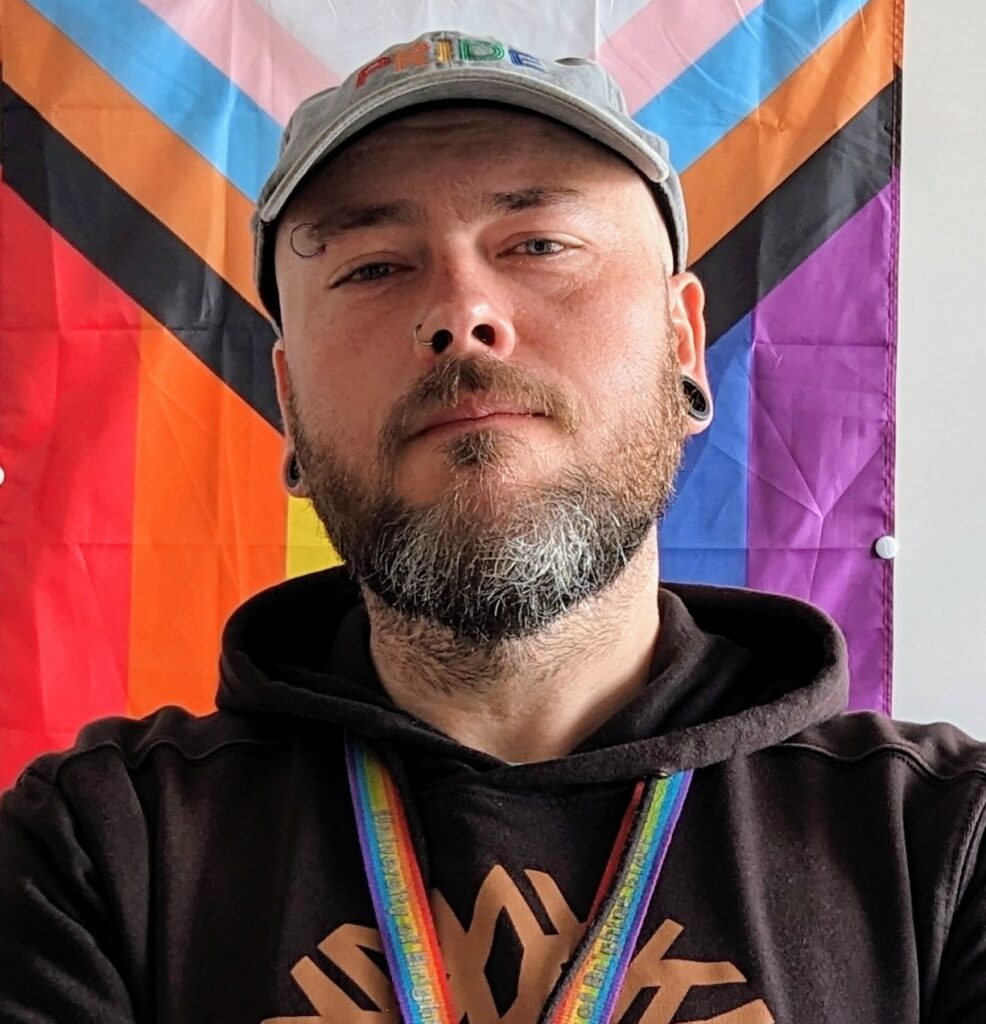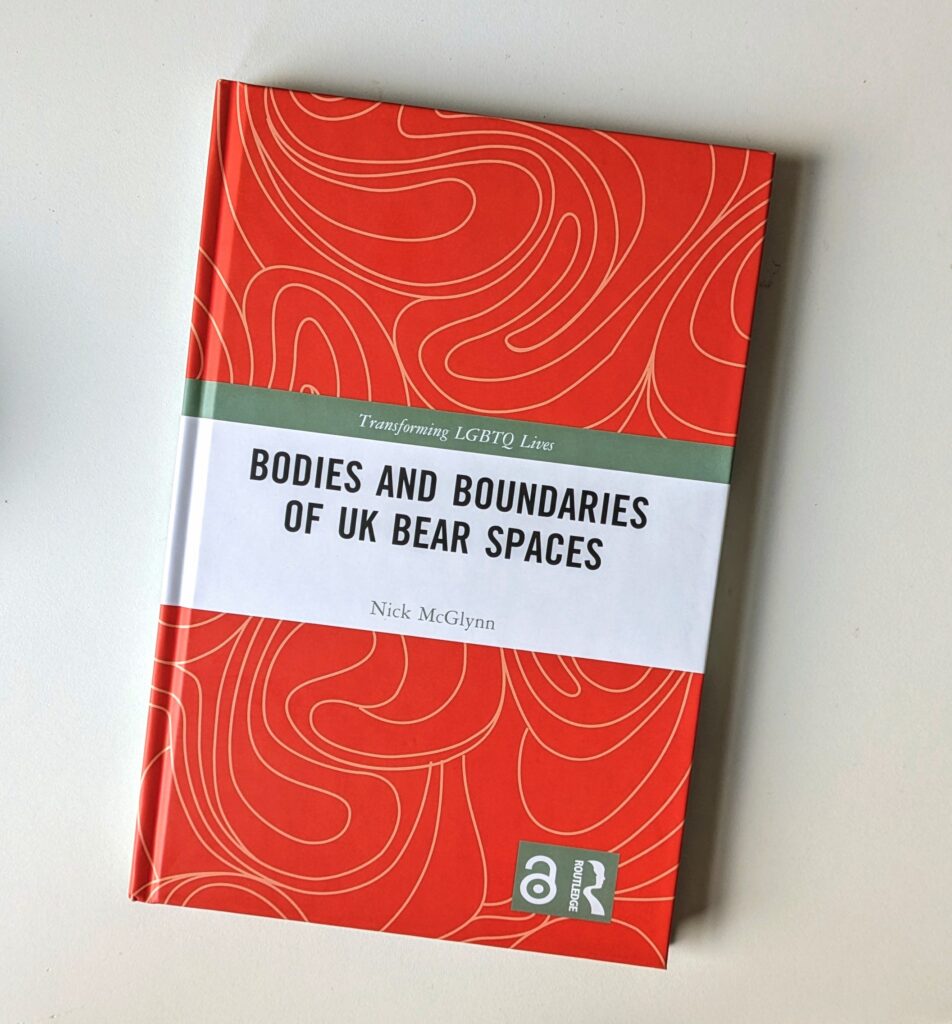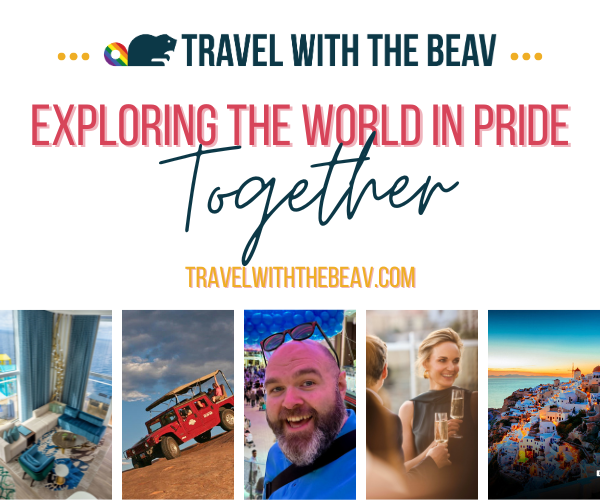
New Book Examines Bear Spaces and Identity in the UK
Dr. Nick McGlynn joins us to discuss his groundbreaking new book Bodies and Boundaries of UK Bear Spaces.
Dr. McGlynn is a researcher at the University of Brighton in addition to being a Senior Lecturer at their School of Applied Sciences, and Deputy Director of its Centre for Transforming Sexuality and Gender.
Bodies and Boundaries of UK Bear Spaces explores the experiences of gay, bi and queer (GBQ) men in spaces used and created by Bear communities in the UK, drawing on data from focus groups, interviews and Dr McGlynn’s own observations.
He wrote the book following research into the UK’s Bear community, drawing on historical and contemporary writing, while including new empirical research into pubs, clubs and events. The book cautions against one-size-fits-all accounts of Bears, and reveals the complexity and variety of Bear bodies, spaces and communities.
Published by Routledge as part of their Transforming LGBTQ Lives series and written for both academic and non-academic readers, the book combines an engaging conversational style with insightful first-hand quotes from focus groups and interviews to help explain new ways of looking at Bears or ‘Bear-y’ men. The publication is both available to purchase, or to view and download online for free.
We sat down with Dr. McGlynn to get some additional insight into the book and his findings.

BWM: What prompted you to take on this type of research?
Dr. Nick McGlynn (NM): I started this research for a couple of reasons. The first was being fat. I’m a bit slimmer now than when I started my research, but I’ve experienced plenty of anti-fat abuse in my life. And I know just how stigmatised fatness is in our society, especially for gay, bi and queer (GBQ) men. I got the impression that Bear social spaces were more inclusive of fat men than regular LGBTQ spaces. So I wanted to see if this impression was correct here in the UK.
I guess the second reason was my feelings about being a Bear. I started calling myself a Bear, and getting called a Bear by others, in my mid-20s. I’m tall, chubby, bearded, and folk tend to read me as a bit more masculine. So Bear was a label that worked for me and that I was comfortable with. But I didn’t really feel strongly about it, and I always wondered if that made me not ‘really’ a Bear. So my research was a chance to explore other guys’ thoughts about their own Bear-ness.
BWM: Can you briefly describe the methodology of how you collected data and what type of information you were gathering?
NM: There were 4 methods that made up my research, the Bearspace project. The first was pretty simple – creating a database of everywhere in the UK that might feasibly be called a ‘Bear space’. I did this through weeks of web-searching and by getting suggestions from Bear groups. I ended up with just nine sites that I felt were undeniably Bear spaces. And that’s really the first big finding – just how few actual Bear spaces we’ve got in the UK! Five of these became case study sites, and with the permission of the owners/organisers I undertook the other three methods in each of them. These were a focus group (on-site) with guys who visited the space, interviews (off-site) with these and other guys who’d been to the space, and then writing up my own observations and reflections about being in the space myself. I ended up with over 700 pages of data, and analysed it using an approach called Reflexive Thematic Analysis (RTA) – a very popular and flexible way of interpreting this kind of data.
BWM: Without giving away too much can you share some of the key takeaways of your research?
NM: I don’t mind giving stuff away! Back in 2022 I published a report and a research paper on the experiences of fat GBQ guys in UK Bear spaces. I found that, yes, UK Bear spaces are felt to be safe and comfortable spaces for fat GBQ men – but that fat stigma still manifests in them. My new book, Bodies and Boundaries of UK Bear Spaces, takes things further and deals with other aspects of Bears and our spaces in the UK.
One big takeaway is that we need to focus on bodies instead of identities when it comes to Bears. Guys in my research didn’t care about identifying as Bears. But they did care about their bodies fitting in with the bodies around them, and they generally categorised guys as Bears through reference to bodies (though it was clear that lots of different bodies can fit into the Bear category!). This actually helps with understanding the dynamics of UK Bear spaces. Most of them are temporary, so they take over a generic bar or club for a night or a weekend. And it’s achieving what I call a critical mass of Bear bodies – an overwhelming majority of us all together – that makes these generic spaces feel like Bear spaces. When that critical mass is disrupted – even by just a few other bodies – then big guys in particular can feel less comfortable and safe, as it’s no longer felt to be a Bear space.
I’m also advocating for a bit of deliberate ambiguity around the term ‘Bear’. It’s never been a simple checklist of measurable traits, that make you either a Bear or not a Bear. Even the (to my mind) Beariest of guys in my research were nonchalant about being a Bear or not, and lots of guys described themselves and others using terms like ‘Bear-y’, ‘Bear-ish’ and ‘Bear-adjacent’. I’m not saying we should drop the term Bear. But instead of trying to impose strict yes/no criteria of ‘Bear’ – which let’s face it most of us will never live up to or maintain – I think we should embrace the uncertainty of being Bear-y.

BWM: Does your personal experience with bears mirror what you found in your research?
NM: There were a few things that really resonated with my experiences, yeah. For instance, I vividly remember the euphoria of taking my top off at a Bear club night back in 2016 – the first time I had ever done this. This came up over and over again in the research, with big guys describing the act of taking their top off in a Bear spaces, and exposing their bellies, as a moment of exhilaration and liberation. I think this simple act is a big deal for many of us. And it definitely surprised me that my uncertainty about whether or not I was ‘really’ a Bear was felt by guys across the UK. Even Bear title-holders and organisers were pretty relaxed about it all, which made me feel relaxed too, like I didn’t have to try too hard to be a ‘real’ Bear!
BWM: What are some common themes or issues you found amongst bears in the UK?
NM: The decline in fixed, permanent and self-described Bear bars, pubs and clubs was definitely an issue in the UK. Here we’re blessed with the Bristol Bear Bar and the Kings Arms, but most have been lost or have gone more generically ‘LGBTQ-friendly’. Guys loved our temporary events, but they said it was harder to build a sense of community without a fixed space. Another issue was with muscle. Fatter guys felt uncomfortable when trim, gym-fit Muscle Bears and ‘Muscle Marys’ dominated Bear spaces, and they usually said these guys had a negative and dismissive attitude. For myself, I know plenty of lovely trim Muscle Bears and muscular guys more generally, and I know they’re not inherently fatphobic or anything. But I can also see why it’s hard to have an atmosphere that celebrates fat bodies when trim muscular bodies – strongly championed in wider straight and GBQ men’s cultures – are present in numbers, and change that critical mass of the space. This is a really tough thing I grapple with in the book, that you might have done nothing wrong but the very presence of your body changes the feel of the space. And it’s another reason I say we need to focus on bodies when studying Bears!
BWM: You have mentioned geographical differences amongst the global bear scenes and even within the UK itself. What are some of the biggest differences you’ve noted amongst bear communities in the UK? Between the UK and the US?
NM: I’ve tried to really ground the book in the UK context, because I’m against global generalisations. Most stuff that’s been written about Bears has focused on the US – and that makes sense given Bear’s history. But the UK’s Bear scenes aren’t just identical to those of the US. And as other Bear researchers like Chi Chun Lin and Vinicius Flauaus have described, neither are those of other countries like Taiwan or Brazil. Regarding the UK, I’ve written about the nation-wide influence of London on the spread of Bear culture, and about how the smaller populations of other UK cities result in more mixed Bear spaces (in terms of bodies, genders, other GBQ men’s communities etc). Even within countries Bear scenes can vary – my book points out how London’s Bear scenes were felt to be quite different to the rest of the UK, with much more of a focus on muscle and with more niche places to go to. This is something I’m eager to study more in the future, hopefully in a more international project.
BWM: Based on your work – what can we do as a community to make it better for ourselves out there?
NM: First it’s to support Bear spaces, both fixed sites or more ephemeral events. It’s use them or lose them – and we’ll feel it when we’ve lost them. Yes there’s a commercial aspect to plenty of Bear stuff including the bars and clubs, but these spaces are also where we can build a sense of community. And second is to support guys with all sorts of bodies in Bear spaces, while not forgetting that some guys’ bodies are marginalised in wider society in a way that others’ aren’t – fat guys of course, but also guys of colour, disabled guys, trans guys and more.
BWM: Anything we have not covered that you’d like to mention?
NM: Just a big thank you to the lads from Manbears, BearScots, Brit Bears, Brighton Bear Weekend and Belfast Bears for supporting the research and taking part!
BWM Awesome! And allow us to thank YOU for this brilliant book and for making it available for free to all of us.
NM: My pleasure!

To purchase the hardcover of download the free eBook of Bodies and Boundaries of UK Bear Spaces head to https://www.routledge.com/Bodies-and-Boundaries-of-UK-Bear-Spaces/McGlynn/p/book/9781032140360.
Links to free downloadable versions of Dr. McGlynn’s other research are also available via his researcher profile: https://research.brighton.ac.uk/en/persons/nicholas-mcglynn.









